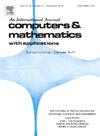Strong approximation of the time-fractional Cahn–Hilliard equation driven by a fractionally integrated additive noise
IF 2.9
2区 数学
Q1 MATHEMATICS, APPLIED
引用次数: 0
Abstract
In this article, we present a numerical scheme for solving a time-fractional stochastic Cahn–Hilliard equation driven by an additive fractionally integrated Gaussian noise. The model involves a Caputo fractional derivative in time of order and a fractional time-integral noise of order . Our numerical approach combines a piecewise linear finite element method in space with a convolution quadrature in time, designed to handle both time-fractional operators, along with the -projection for the noise. We conduct a detailed analysis of both spatially semidiscrete and fully discrete schemes, deriving strong convergence rates through energy-based arguments. The solution's temporal Hölder continuity played a key role in the error analysis. Unlike the stochastic Allen–Cahn equation, the inclusion of the unbounded elliptic operator in front of the cubic nonlinearity in our model added complexity and challenges to the error analysis. To address these challenges, we introduce novel techniques and refined error estimates. We conclude with numerical examples that validate our theoretical findings.
分数积分加性噪声驱动的时间分数Cahn-Hilliard方程的强逼近
在本文中,我们提出了一种数值方案,用于求解由加性分数积分高斯噪声驱动的时间分数随机卡恩-希利亚德方程。该模型涉及阶数为α∈(0,1)的卡普托分数时间导数和阶数为γ∈[0,1]的分数时间积分噪声。我们的数值方法结合了空间的分片线性有限元法和时间的卷积正交法,旨在处理这两个时间分数算子以及噪声的 L2 投影。我们对空间半离散和完全离散方案进行了详细分析,通过基于能量的论证得出了强大的收敛率。解的时间荷尔德连续性在误差分析中起到了关键作用。与随机 Allen-Cahn 方程不同,我们的模型在立方非线性前加入了无界椭圆算子,这增加了误差分析的复杂性和挑战性。为了应对这些挑战,我们引入了新技术和完善的误差估计。最后,我们通过数值示例验证了我们的理论发现。
本文章由计算机程序翻译,如有差异,请以英文原文为准。
求助全文
约1分钟内获得全文
求助全文
来源期刊

Computers & Mathematics with Applications
工程技术-计算机:跨学科应用
CiteScore
5.10
自引率
10.30%
发文量
396
审稿时长
9.9 weeks
期刊介绍:
Computers & Mathematics with Applications provides a medium of exchange for those engaged in fields contributing to building successful simulations for science and engineering using Partial Differential Equations (PDEs).
 求助内容:
求助内容: 应助结果提醒方式:
应助结果提醒方式:


